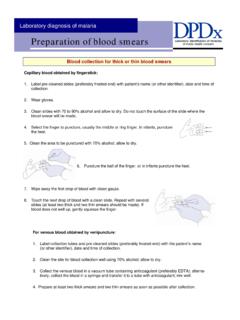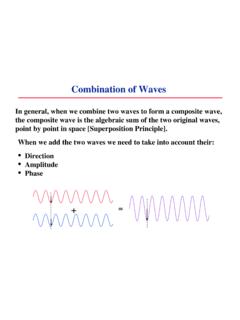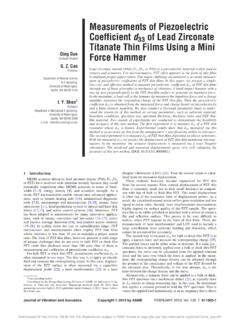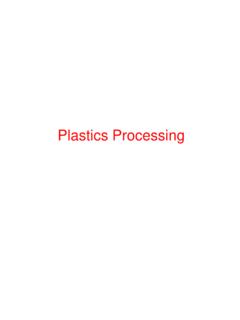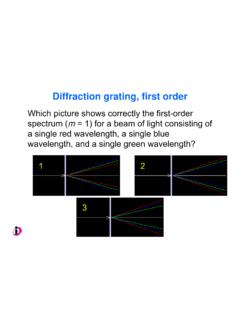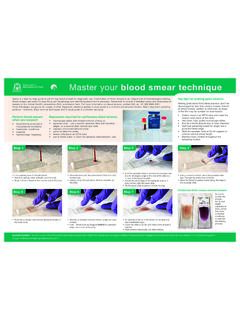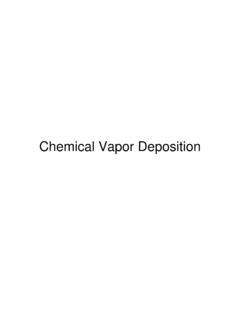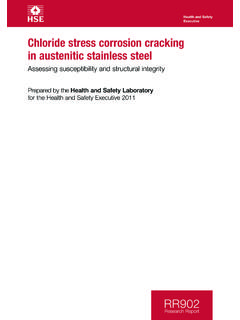Transcription of AP-42, CH 12.20: Electroplating
1 ElectroplatingThis section addresses the Electroplating industry. However, emphasis is placed on chromiumelectroplating and chromic acid anodizing because the majority of emissions data and otherinformation available were for this area of the Electroplating industry. Detailed information on theprocess operations, emissions, and controls associated with other types of Electroplating will be addedto this section as it becomes available. The six-digit Source Classification Code (SCC) forelectroplating is Process Description1-4 Electroplating is the process of applying a metallic coating to an article by passing an electriccurrent through an electrolyte in contact with the article, thereby forming a surface having propertiesor dimensions different from those of the article.
2 Essentially any electrically conductive surface canbe electroplated. Special techniques, such as coating with metallic-loaded paints or silver-reducedspray, can be used to make nonconductive surfaces, such as plastic, electrically conductive forelectroplating. The metals and alloy substrates electroplated on a commercial scale are cadmium,chromium, cobalt, copper, gold, indium, iron, lead, nickel, platinum group metals, silver, tin, zinc,brass, bronze, many gold alloys, lead-tin, nickel-iron, nickel-cobalt, nickel-phosphorus, tin-nickel, tin-zinc, zinc-nickel, zinc-cobalt, and zinc-iron. Electroplated materials are generally used for a specificproperty or function, although there may be some overlap, e. g., a material may be electroplated fordecorative use as well as for corrosion essential components of an Electroplating process are an electrode to be plated (thecathode or substrate), a second electrode to complete the circuit (the anode), an electrolyte containingthe metal ions to be deposited, and a direct current power source.
3 The electrodes are immersed in theelectrolyte with the anode connected to the positive leg of the power supply and the cathode to thenegative leg. As the current is increased from zero, a point is reached where metal plating begins tooccur on the cathode. The plating tank is either made of or lined with totally inert materials to protectthe tank. Anodes can be either soluble or insoluble, with most Electroplating baths using one or theother type. The majority of power supplies are solid-state silicon rectifiers, which may have a varietyof modifications, such as stepless controls, constant current, and constant voltage. Plate thickness isdependent on the cathode efficiency of a particular plating solution, the current density, and theamount of plating time.
4 The following section describes the Electroplating process. Following thedescription of chromium plating, information is provided on process parameters for other types Chromium Electroplating -Chromium plating and anodizing operations include hard chromium Electroplating of metals,decorative chromium Electroplating of metals, decorative chromium Electroplating of plastics, chromicacid anodizing, and trivalent chromium plating. Each of these categories of the chromiumelectroplating industry is described Chromium Electroplating -In hard plating, a relatively thick layer of chromium is deposited directly on the base metal(usually steel) to provide a surface with wear resistance, a low coefficient of friction, hardness, andcorrosion resistance, or to build up surfaces that have been eroded by use.
5 Hard plating is used foritems such as hydraulic cylinders and rods, industrial rolls, zinc die castings, plastic molds, enginecomponents, and marine presents a process flow diagram for hard chromium Electroplating . The processconsists of pretreatment, alkaline cleaning, acid dipping, chromic acid anodizing, and chromiumelectroplating. The pretreatment step may include polishing, grinding, and degreasing. Degreasingconsists of either dipping the part in organic solvents, such as trichloroethylene or perchloroethylene,or using the vapors from organic solvents to remove surface grease. Alkaline cleaning is used todislodge surface soil with inorganic cleaning solutions, such as sodium carbonate, sodium phosphate,or sodium hydroxide.
6 Acid dipping, which is optional, is used to remove tarnish or oxide filmsformed in the alkaline cleaning step and to neutralize the alkaline film . Acid dip solutions typicallycontain 10 to 30 percent hydrochloric or sulfuric acid. Chromic acid anodic treatment, which also isoptional, cleans the metal surface and enhances the adhesion of chromium in the Electroplating final step in the process is the Electroplating operation plating tanks typically are equipped with some type of heat exchanger. Mechanicalagitators or compressed air supplied through pipes on the tank bottom provide uniformity of bathtemperature and composition. Chromium Electroplating requires constant control of the plating bathtemperature, current density, plating time, and bath chromium plating baths are the most widely used baths to deposit chromium onmetal.
7 Hexavalent chromium baths are composed of chromic acid, sulfuric acid, and water. Thechromic acid is the source of the hexavalent chromium that reacts and deposits on the metal and isemitted to the atmosphere. The sulfuric acid in the bath catalyzes the chromium deposition evolution of hydrogen gas from chemical reactions at the cathode consumes 80 to90 percent of the power supplied to the plating bath, leaving the remaining 10 to 20 percent for thedeposition reaction. When the hydrogen gas evolves, it causes misting at the surface of the platingbath, which results in the loss of chromic acid to the Chromium Electroplating -Decorative chromium Electroplating is applied to metals and plastics. In decorative plating ofmetals, the base material generally is plated with layers of copper and nickel followed by a relativelythin layer of chromium to provide a bright surface with wear and tarnish resistance.
8 Decorativeplating is used for items such as automotive trim, metal furniture, bicycles, hand tools, and presents a process flow diagram for decorative chromium Electroplating . Theprocess consists of pretreatment, alkaline cleaning, and acid dipping, which were described previously,followed by strike plating of copper, copper Electroplating , nickel Electroplating , and chromiumelectroplating. The copper strike plating step consists of applying a thin layer of copper in a coppercyanide solution to enhance the conductive properties of the base metal. Following the copper strikeplate, the substrate is acid dipped again, and then electroplated with an undercoat of copper to improvecorrosion resistance and cover defects. Either a copper cyanide or acid copper solution is used in thisstep.
9 The substrate then is plated with nickel in two layers (semibright nickel and bright nickel) tofurther improve corrosion resistance and activate the surface metal for chromium FACTORS7/96 Figure Flow diagram for a typical hard chromium plating (Source Classification Codes in parentheses.)7/96 Metallurgical Flow diagram for decorative chromium plating on a metal (Source Classification Codes in parentheses.) FACTORS7/96 Semibright and bright nickel plating both use Watts plating baths. The final step in the process is theelectroplating operation Electroplating baths operate on the same principle as that of the hard chromiumplating process. However, decorative chromium plating requires shorter plating times and operates atlower current densities than does hard chromium plating.
10 Some decorative chromium platingoperations use fluoride catalysts instead of sulfuric acid because fluoride catalysts, such as fluosilicateor fluoborate, have been found to produce higher bath plastics that are electroplated with chromium are formed from acrylonitrile butadienestyrene (ABS). The process for chromium Electroplating of ABS plastics consists of the followingsteps: chromic acid/sulfuric acid etch; dilute hydrochloric acid dip; colloidal palladium activation;dilute hydrochloric acid dip; electroless nickel plating or copper plating; and chromium electroplatingcycle. After each process step, the plastic is rinsed with water to prevent carry-over of solution fromone bath to another. The Electroplating of plastics follows the same cycle as that described fordecorative chromium Acid Anodizing -Chromic acid anodizing is used primarily on aircraft parts and architectural structures that aresubject to high stress and corrosion.










